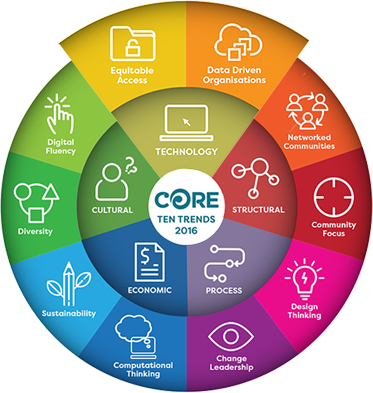Equitable access

In recent years, as technology has become more affordable and accessible, it has permeated across society creating change in the way we work, learn and communicate with each other. Technology provides real opportunity to transform education, to make a difference for all our learners, in ways that have not been possible before. However, technology in itself will not make this difference, rather it needs partnered with good pedagogy, well designed teaching and learning environments, and equitable access. In doing this, barriers to learning are removed and all learners are enabled to access information, to create and collaborate in a way that works for them.
The 2014 “Future-focused learning in connected communities” report emphasised the need for learners to have equitable access to digital technologies, regardless of location, background, abilities or socio-economic status: “We expect all learners to have an equitable opportunity to achieve education success. We expect education to equip them to: live harmoniously in an increasingly diverse society contribute to solving today’s complex social, economic and environmental problems pursue activities that promote their health and well-being”.
Implications for education
The combination of access to, and the use of technology can contribute to a digital divide or digital inequity. This can have a profound effect on academic success and economic opportunity for those who live in under resourced communities.
One key aspect of this digital divide is learners’ access to technology through digital devices, strong infrastructure and internet capability. With the provision of UFB internet services in New Zealand schools, and as the cost of technology reduces, access to technology is improving.
Many education environments have or are moving towards a Bring Your Own Device (BYOD) environment where learners bring their own tablet, laptop or smartphone to school with them. These devices are owned or leased by families, or in some instances supported through community initiatives so they remain with the learner. Having access to the device both at home and at school has the potential to create a seamless and ubiquitous learning environment and provide teachers with options to reimagine how their teaching and learning might look. An example of this is flipped learning where content learning is often completed at home thereby creating more time in class for discussion and collaboration to cement the learning.
The second key aspect of the digital divide involves the ways in which technologies are being used to support teaching and learning. There can be significant differences in use and access within a learning environment and between learning environments with many learners and teachers bound by constraints. Many factors contribute to this inequity of use including understanding future focused pedagogy, teachers digital competence, community resources and collaboration. Addressing any of these involves challenges, and requires planning, vision and strategies over a period of time but it is vital that educators are tackling this now as digital devices are integral for teaching and learning in this knowledge age.
It is in this knowledge age that technologies really support learning through not only providing opportunities to collaborate and co-construct knowledge on a global level but by affording access to current and most-up-to-date resources as we need them. No longer reliant on a textbook, teachers and learners can access as well as create their own learning materials and artefacts - all of which can be tailored to their own environment and needs.
Ensuring equitable access applies to children in early childhood services as much as to students at school. The high level of involvement of parents and whānau in early childhood services provides ideal opportunities to establish the effective use of digital technologies for learning right from the outset.
The Open Education Resources (OER) movement provides a library of digital resources that support teaching and learning with educators freely sharing resources, pedagogy and materials for other teachers and students to use and modify at no cost. The implication of this is access to relevant and current content and strategies for free which teachers, learners and families can draw upon.
Questions to consider
Partnerships with our communities are key as we bridge this digital divide and really personalise learning for all our learners.
- How can we draw on existing community partnerships and build new ones to support our learners?
- How can community hubs, such as libraries, be a integral point of collaboration?
- How can we collaborate on a global level to bring authenticity to projects?
-
Links
-
Research
2014 Report The 2020 Communications Trust’s 2014 Digital Technology in Schools report covers strategic planning in relation to digital technologies, student access to personal digital devices for learning, digital technologies being used for the purposes of student learning. internet access and safety, digital Te Reo Māori resources being used, and the impact of digital technologies on student learning and teacher professional development.
Supporting future-oriented learning and teaching: a New Zealand perspective
This 2012 research project draws together findings from new data and more than 10 years of research on current practice and futures-thinking in education. The report discusses some emerging principles for future learning, how these are currently expressed in New Zealand educational thinking and practice and what they could look like in future practice.
Future-focused learning in connected communities: a report by the 21st Century Learning Reference Group (PDF, 942 KB)
The focus of this report is on transforming teaching and learning, enabled by technologies that are now widespread in our society. Digital technologies play an increasingly critical role in shaping and supporting an effective 21st century curriculum.